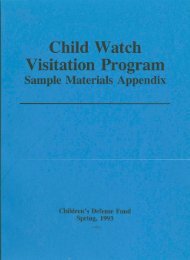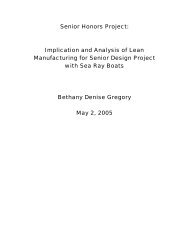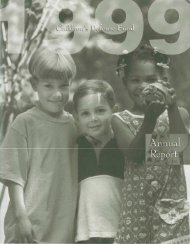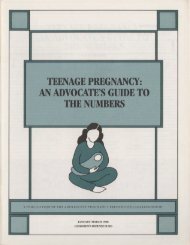children out of school in america - University of Tennessee Digital ...
children out of school in america - University of Tennessee Digital ...
children out of school in america - University of Tennessee Digital ...
Create successful ePaper yourself
Turn your PDF publications into a flip-book with our unique Google optimized e-Paper software.
This chapter presents our analysis <strong>of</strong> the two pr<strong>in</strong>cipal<br />
sources <strong>of</strong> data on <strong>children</strong> <strong>out</strong> <strong>of</strong> <strong>school</strong>: (1)<br />
1970 United States Census data on nonenrollment,<br />
and (2) the results from our own household survey<br />
<strong>in</strong> n<strong>in</strong>e states and the District <strong>of</strong> Columbia.<br />
u.s. Census Data on Nonenrollment 1<br />
Accord<strong>in</strong>g to the 1970 Census, nearly two million<br />
<strong>school</strong>-age <strong>children</strong> 7 to 17 were not enrolled <strong>in</strong> any<br />
<strong>school</strong> three consecutive months prior to enumeration<br />
<strong>in</strong> April, 1970. More than one million <strong>of</strong> them<br />
were between the ages <strong>of</strong> 7 and 15. Over threequarters<br />
<strong>of</strong> a million were elementary <strong>school</strong>-age<br />
cllildren 7 to 13.<br />
t The 1970 Census asked <strong>of</strong> persons <strong>in</strong> a 15 percent sample<br />
whether they had attended "regular" (public or private)<br />
<strong>school</strong> or college at any time between February I, 1970,<br />
and the time <strong>of</strong> enumeration. Though the question was<br />
phrased <strong>in</strong> terms <strong>of</strong> <strong>school</strong> attendance, it was <strong>in</strong>terpreted by<br />
the Census Bureau to reflect nonenrollment.<br />
It is impossible to tell exactly how long a child had to<br />
be <strong>out</strong> <strong>of</strong> <strong>school</strong> to be enumerated "not enrolled" by the<br />
Census Bureau. A Census questionnaire was delivered by<br />
postal carriers to every household several days before Census<br />
Day, April I, 1970. In the larger metropolitan areas<br />
and some adjacent counties, altogether conta<strong>in</strong><strong>in</strong>g ab<strong>out</strong><br />
three-fifths <strong>of</strong> the population <strong>of</strong> the United States, the<br />
householder was requested to fill <strong>out</strong> and mail back the<br />
form on Census Day. Approximately 87 percent <strong>of</strong> the<br />
householders did so. The mailed-back forms were reviewed<br />
by the Census enumerator (or, <strong>in</strong> some localities, a Census<br />
clerk) and if the form was determ<strong>in</strong>ed to be <strong>in</strong>complete or<br />
<strong>in</strong>consistent, a follow-up contact was made. The bulk <strong>of</strong><br />
Chapte,.2<br />
Ho,v Many Children<br />
Are Out <strong>of</strong> School?<br />
There are <strong>children</strong> <strong>out</strong> <strong>of</strong> <strong>school</strong> all over the nation.<br />
They are white, black and brown, rich and<br />
poor, from families with all k<strong>in</strong>ds <strong>of</strong> <strong>in</strong>come and<br />
educational levels. There is no statistical group<strong>in</strong>g<br />
<strong>of</strong> any size that does not show some <strong>of</strong> its <strong>children</strong><br />
<strong>out</strong> <strong>of</strong> <strong>school</strong>. Some k<strong>in</strong>ds <strong>of</strong> <strong>children</strong>, however, are<br />
more likely than others to be <strong>out</strong> <strong>of</strong> <strong>school</strong>. Census<br />
data beg<strong>in</strong> to draw a picture <strong>of</strong> the child <strong>out</strong> <strong>of</strong><br />
<strong>school</strong> as one wllo is <strong>in</strong> some way different - racially,<br />
ethnically or economically. While it is clear<br />
from the figures that be<strong>in</strong>g <strong>out</strong> <strong>of</strong> <strong>school</strong> affects all<br />
ages, it is equally clear that the older a child gets,<br />
the more likely he or she will have difficulty stay<strong>in</strong>g<br />
<strong>in</strong> <strong>school</strong>. For many <strong>children</strong>, ages 16 and 17 are<br />
years when they f<strong>in</strong>ally give up on the <strong>school</strong> system<br />
and when the <strong>school</strong> system gives up on them.<br />
these follow-ups were made by telephone, the rest by personal<br />
visit. For the households which did not mail back<br />
their forms, a follow-up contact was also made, <strong>in</strong> almost<br />
all cases by personal visit and <strong>in</strong> the rema<strong>in</strong>der by telephone.<br />
For the rema<strong>in</strong><strong>in</strong>g two-fifths <strong>of</strong> the population. the<br />
householder was requested to fill <strong>out</strong> the form and give it<br />
to the enumerator when he visited; approximately 80 percent<br />
did so. Incomplete and unfilled forms were completed<br />
by <strong>in</strong>terview dur<strong>in</strong>g the enumerator's visit.<br />
S<strong>in</strong>ce there was no way <strong>of</strong> tell<strong>in</strong>g where or how many<br />
households completed Census questionnaires at any given<br />
time <strong>in</strong> April, 1970, CDF assumed for purposes <strong>of</strong> this<br />
study that the Census nonenrollment figure referred to<br />
three consecutive months <strong>out</strong> <strong>of</strong> <strong>school</strong> (from February I<br />
to April 30, 1970). We know this is an extremely cautious<br />
assumption.<br />
See Appendix A for the methodology used to analyze<br />
Census data.<br />
33














